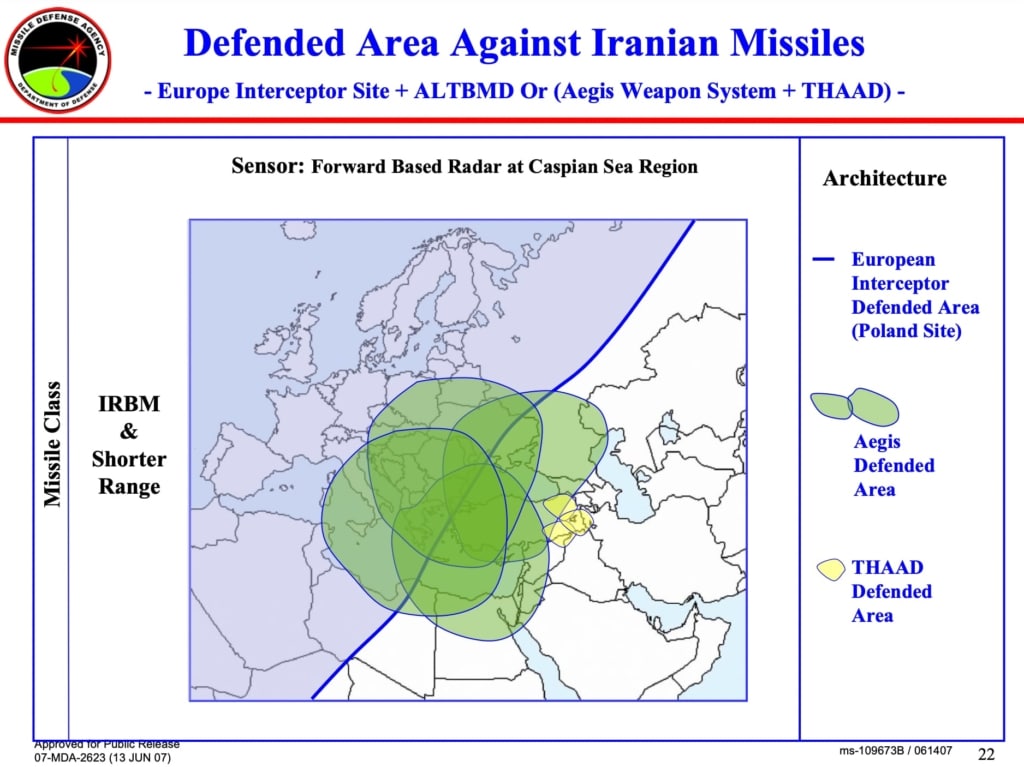WON'T DO MUCH GOOD If Iran FIRES 200 BALLISTIC MISSILES- SEE THAAD DRIVE
See:
https://t.me/Middle_East_Spectator/11135
^^^ THAAD components
THAAD incorporates four main components: the interceptor, launch vehicle, radar, and fire control system.
THAAD interceptor
-
 Comparison of Aegis and THAAD defended area. Photo credit: MDA
Comparison of Aegis and THAAD defended area. Photo credit: MDA
The THAAD interceptor is 6.2 meters long, 0.4 meters in diameter, and weighs 662 kg at launch. It consists of single-stage, solid-propellant booster and a liquid-fueled kinetic kill vehicle. The missile’s booster is constructed from carbon fiber and uses a hydroxyl-terminated polybutadiene (HTPB) propellant. It employs a thrust vector system for control and a deployable rear flare for stability. The THAAD kill vehicle is constructed from composites and uses a gimbaled infrared seeker to track targets in the terminal phase. After approaching the target with its main booster, the THAAD kill vehicle separates and uses its hydrazine-powered divert thrusters to maneuver in its final trajectory.
The THAAD system defend targets at ranges of 150 – 200 km. Unlike other missile defense systems, THAAD can intercept targets within (endoatmospheric) and outside (exoatmospheric) the atmosphere.
THAAD launcher
The THAAD launcher is based on a 4-axle heavy expanded mobility tactical truck (HEMTT). Each launcher carries up to eight interceptors, which are housed in 6.6 m long, 1,044 kg launch canisters. There are eight interceptors per launcher. A typical THAAD battery includes 6 launchers, and each launcher takes up to 30 minutes to reload.
AN/TPY-2 radar
The THAAD system utilizes the Army Navy/Transportable Radar Surveillance (AN/TPY-2) radar to detect and track enemy missiles at ranges of 870 to 3,000 km. The AN/TPY-2 radar is deployable in two modes: a forward-based mode (FBM), where it detects missiles in the ascent phase to cue other BMDS elements, and a terminal mode (TM), where it provides tracking and engagement data for terminal THAAD engagements.
The AN/TPY-2 radar includes four major subsystems: the main antenna, or Antenna Equipment Unit (AEU), the Electronic Equipment Unit (EEU), the Cooling Equipment Unit (CEU), and the Prime Power Unit (PPU).
The AEU is the main radiating element of the AN/TPY-2 and operates in the X-band. Its high operating resolution allows it to more effectively cue engagements and discriminate targets from decoys and debris. The trailer-mounted system has a 9.2m^2 phased-array antenna face with over 25,000 antenna modules.
Three other trailers—the EEU, CEU, and PPU—provide the requisite processing, refrigerated coolant, and electrical power to continue operations. The antenna and electronics units connect with THAAD fire control elements with fiber optic cables, and the cooling and power units feed chilled coolant and power to the other radar subsystems.
THAAD Fire Control and Communications System
The THAAD Fire Control and Communications (TFCC) component oversees battery operations and relays fire control information to other elements of the joint force. Each system, known as a Tactical Station Group (TSG), incorporates a Tactical Operations Station (TOS) with two operating stations, a Launch Control Station (LCS), which includes wireless datalinks, networking equipment, and fiber optic cable interfaces, and a Station Support Group (SSG) which includes HMMWV-based antenna and cable support vehicles.
Operating in concert, these systems control battery launch operations and transfer fire control information from the AN/TPY-2 radar to the larger Command, Control, Battle Management, and Communications (C2BMC) network. By connecting with C2BMC, THAAD can exchange tracking data with Aegis, GMD, and Patriot missile defense. MDA first demonstrated a THAAD-cued Patriot intercept in 2020.
THAAD launchers. Photo: MDA
https://missilethreat.csis.org/system/thaad/
***
z173